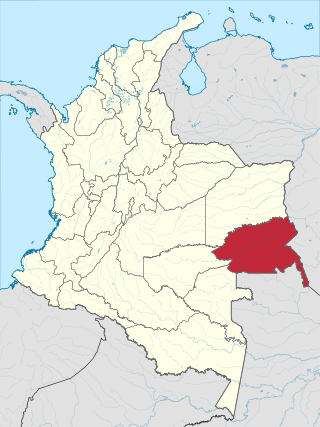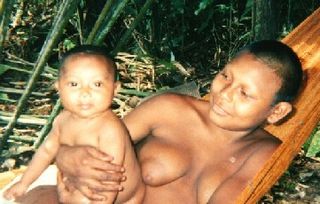
The Arawak are a group of indigenous peoples of northern South America and of the Caribbean. Specifically, the term "Arawak" has been applied at various times to the Lokono of South America and the Taíno, who historically lived in the Greater Antilles and northern Lesser Antilles in the Caribbean. All these groups spoke related Arawakan languages.

The Kakwa people are a Nilotic ethnic group and part of the Karo people found in north-western Uganda, south-western South Sudan, and north-eastern Democratic Republic of the Congo, particularly to the west of the White Nile river.

Guainía is a department of Eastern Colombia. It is in the east of the country, bordering Venezuela and Brazil. Its capital is Inírida. In 1963 Guainía was split off from Vaupés department. The northern part and the Inírida River are included in the Orinoco basin; the rest is part of the Amazon basin. The Guaviare River is the main area of colonization; many colonos come from the Colombian Andean zone, most of them from Boyacá. They are followed by the llaneros, people from the Eastern plains (Llanos). The population is mainly composed of Amerindians, and the largest ethnic groups are the Puinaves and the curripacos. There are a total of 24 ethnic groups in the department; many of them speak four Indigenous languages besides Spanish and Portuguese.

Vaupés is a department of Southeastern Colombia in the jungle covered Amazonas Region. It is located in the southeast part of the country, bordering Brazil to the east, the department of Amazonas to the south, Caquetá to the west, and Guaviare, and Guainía to the north; covering a total area of 54,135 km2. Its capital is the town of Mitú.
The Naduhup languages, also known as Makú (Macú) or Vaupés–Japurá, form a small language family in Brazil, Colombia, and Venezuela. The name Makú is pejorative, being derived from an Arawakan word meaning "without speech". Nadahup is an acronym of the constituent languages.
Máku, also spelled Mako, and in the language itself Jukude, is an unclassified language and likely language isolate once spoken on the Brazil–Venezuela border in Roraima along the upper Uraricoera and lower Auari rivers, west of Boa Vista, by the Jukudeitse. 300 years ago, the Jukude territory was between the Padamo and Cunucunuma rivers to the southwest.

The Nukak[nɨkãk] people live between the Guaviare and Inírida rivers, in the depths of the tropical humid forest, on the fringe of the Amazon basin, in Guaviare Department, Republic of Colombia. They are nomadic hunter-gatherers with seasonal nomadic patterns and practice small-scale shifting horticulture. They were classified as "uncontacted people" until 1981, and have since lost half of their population primarily to disease. Part of their territory has been used by coca growers, ranchers, and other settlers, as well as being occupied by guerrillas, army and paramilitaries. Responses to this crisis include protests, requests for assimilation, and the suicide of leader Maw-be'. An estimated 210–250 Nukak people live in provisional settlements at San José del Guaviare, while about as many live nomadically in the Nukak Reservation (Resguardo).
The Hupda are an Amazonian indigenous people who live in Brazil and Colombia. They speak the Hup language.

The Tucano people are a group of Indigenous South Americans in the northwestern Amazon, along the Vaupés River and the surrounding area. They are mostly in Colombia, but some are in Brazil. They are usually described as being made up of many separate tribes, but that oversimplifies the social and linguistic structure of the region.
The Cubeo are an ethnic group of the Vaupés Department (Colombia). Cubeo is a generic name that is used in local Spanish and appears in the literature in reference to a social and linguistic group. Although the term does not have any meaning in their language, the Cubeo refer to themselves by that name in interactions with others. There is no common native name, aside from referring to themselves as "people" (pâmiwâ) or, more precisely, "my people" (jiwa). An individual's social identification is based on his or her adscription to a mythical clan forebear whose name is used as an eponym.
Barasana (alternate names Barazana, Panenua, Pareroa, or Taiwano is an exonym applied to an Amazonian people, considered distinct from the Taiwano, though the dialect of the latter is almost identical to that of the Barasana, and outside observers can detect only minute differences between the two languages. They are a Tucanoan group located in the eastern part of the Amazon Basin in Vaupés Department in Colombia and Amazonas State in Brazil. As of 2000, there were at least 500 Barasanas in Colombia, although some recent estimates place the figure as high as 1,950. A further 40 live on the Brazilian side, in the municipalities of Japurá and São Gabriel da Cachoeira.
The Nukak language is a language of uncertain classification, perhaps part of the macrofamily Puinave-Maku. It is very closely related to Kakwa.
Barasana is one of the various languages spoken by the Indigenous peoples of the Americas belonging to the Amazonian region, specifically in Colombia. It belongs to the Eastern branch of the Tucanoan language family. The people who speak the language are also known as the Barasana. The population of its native speakers is about 1,990 according to a census taken in 1993. Native speakers' tribes are spread out among the Pira Paraná River in Colombia and the banks of the Vaupés River Basin.
The Cacua language, also known as Kakua or Kakwa, is an indigenous language spoken by a few hundred people in Colombia and Brazil. There are many monolinguals, especially children. Apart from being close to or a dialect of Nukak, its classification is uncertain.
Ticuna–Yuri is a small family, perhaps even a dialect continuum, consisting of at least two, and perhaps three, known languages of South America: the major western Amazonian language Ticuna, the poorly attested and extinct Yurí, and the scarcely known language of the largely uncontacted Carabayo. Kaufman also adds Munichi to the family.
Macro-Puinavean is a hypothetical proposal linking some very poorly attested languages to the Nadahup family. The Puinave language is sometimes linked specifically with the Nadahup languages and Nukak-Kakwa group, as Puinave–Maku. Paul Rivet (1920) and other researchers proposed decades ago the hypothesis of a Puinave-Makú family. Later, Joseph Greenberg (1987) grouped the Puinave-Makú languages, together with the Tucano family, the Katukinan, Waorani and Ticuna languages in the Macro-Tukano trunk.
Maku or Maco is a pejorative term referring to several hunter-gatherer peoples of the upper Amazon, derived from an Arawakan term ma-aku "do not speak / without speech". Nimuendajú (1950), for example, notes six peoples of Colombia, Venezuela, and Brazil that are known as 'Maku'. In linguistic literature, the term refers primarily to:
The Carabayo are an uncontacted people of Colombia living in at least three long houses, known as malokas, along the Rio Puré in the southeastern corner of the country. They live in the Amazonas Department of Colombian Amazon rainforest, near the border with Brazil. They share the protected National Park with the Passé and Jumana people.





